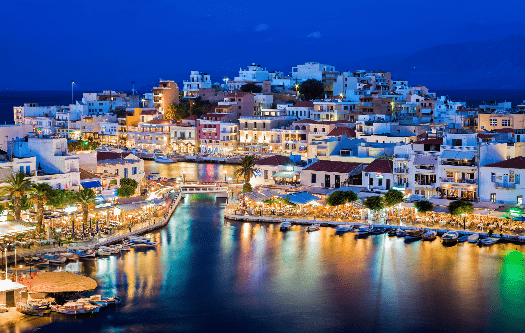Where is the Crete Region of Greece?
The Crete Region is approximately 160 km, or 99 miles, south from mainland Greece. Crete is the largest island of Greece, and the fifth largest island in the Mediterranean Sea.
To the north, separated by the Sea of Crete, is the South Aegean region (which consists of the Cyclades and Dodecanese islands). To the east is Cyprus, to the south is Libya and Egypt, and to the northwest is the Peloponnese region.
The capital city is Heraklion.
The six main cities of the Crete Region are:
– Agios Nikolaos
– Chania
– Heraklion
– Ierapetra
– Rethymno
– Sitia
What does the Crete Region of Greece have to offer?
There are two airports:
– Heraklion
– Chania
And six ports:
– Agios Nikolaos
– Souda, near Chania
– Heraklion
– Kissamos
– Rethymnon
– Sitia
Agriculture
Even though only about one-third of Crete’s total area can be cultivated, it is one of the top agricultural regions of Greece.
Agricultural products/activities include:
– Vegetables (peppers, potatoes, zucchini, tomatoes, cucumbers)
– Fruit (oranges, cherries, apples, grapes)
– Olives and olive oil
– Carob beans (carob ice cream is delicious)
– Sheep and goat husbandry
– Nuts
– Herbs (oregano, sage, mountain tea, camomile flowers)
– Wild greens (more than 100 edible horta)
– Thyme honey
– Cheese (Anthotiro, Myzithra, Pichtogalo Chanion, Xigalo)
– Yogurt
– Wine
Olive Oil
The olive oil produced in Crete accounts for 30 percent of Greece’s olive oil, and is consumed more on this island than anywhere else in the world (per capita).
Most of the Cretan olive oil is organic, and is pressed in private ‘olive factories’, or at monasteries like Toplou. The town of Sitia (located in the most eastern part of Crete) is well known for producing some of the best olive oils in the world.
Wine
Crete produces about 20% of all Greek wine. Much of that is blended wine, or what you get when you order ‘house wine’ at a restaurant. However, there are many wineries and vineyards that produce amazing bottled wine, and offer tastings and tours to visitors.
A few wineries worth mentioning are Minos-Miliarakis, Lyrarakis, Douloufakis, and Rhous-Tamiolakis.
Raki
Raki (also called Tsikoudia) is made from the seeds and skins of grapes after they have been used to make wine. Raki is Crete’s symbol of friendship and hospitality.
There is always a glass of Raki to welcome guests, to toast a celebration, to make amends after a disagreement, or to discuss the day’s events at a traditional cafe. In fact, it would be considered rude not to offer a visitor a glass, as it is an integral part of any social interaction.
In the winter, warmed Raki (Rakomelo) is delicious and soothing if you’re feeling under the weather or a bit chilled. An easy recipe is 120 ml (1/2 cup) raki; 1 heaping tbsp honey; 1 stick of cinnamon; 2-3 cloves. Put ingredients in a small pot, heat on medium until just before it comes to a boil. Strain and enjoy.
Beaches
The island of Crete is famous for its many beautiful beaches along its 1,046 meters (650 miles) of coastline. Crystal clear waters draw thousands of tourists yearly to enjoy sun, sand, and natural beauty.
Some of Crete’s most popular beaches are:
– Balos Beach (60 km north west of Chania)
– Elafonissi Beach (82 km northwest of Chania)
– Vai Beach (25 km east of Sitia)
– Falassarna Beach (58 km west of Chania)
– Preveli Beach (40 km south of Rethymno)
– Loutraki Beach (12km east of Chania)
– Plakias Beach (40 km south of Rethymno)
– Sissi Beach (40 km east of Heraklion)
– Matala Beach (67 km southwest of Heraklion)
– Istro Beach (12 km south of Agios Nikolaos)
– Lentas Beach (75 km southwest of Heraklion)
Restaurants
Bursting with fresh ingredients and intense flavours, Crete’s traditional cuisine is known as one of the best examples of the Mediterranean diet. Produce is locally sourced from nearby farms and villages which grow seasonal fruits, vegetables, wild greens, herbs, and olives.
When dining out at Cretan restaurants, guests are sometimes offered a meze to start (often consisting of local olives and bread). And more than likely, a delicious dessert and a small bottle of Raki will be on the house at the end of the meal.
As always when in Greece, finding a family-run taverna where traditional local dishes are made is like finding gold. Many use their own farm-fresh produce, pick wild greens from the mountains earlier that day, get their lamb from a local shepherd, and select their fish daily from a local fisherman.
There are many restaurants to choose from in Crete that can accommodate all types of budgets and tastes, from traditional tavernas to high end restaurants.
– Agios Nikolaos Restaurants
– Chania Restaurants
– Heraklion Restaurants
– Ierapetra Restaurants
– Rethymno Restaurants
– Sitia Restaurants
Tourism
The northern and southern areas of Crete are separated by a line of mountains that stretch across the centre of the island, almost like a spine.
The northern cities of Crete (Chania, Rethymno, Heraklion, and Agios Nikoloas) offer shopping, cafes, restaurant-lined harbours, cybercafes, and nightlife. The Chania Market is a wonderful place to taste and buy local products. These coastal cities are the most popular tourist destinations on the island.
The southern coast is perfect for those wanting to escape touristy areas, but still want to enjoy a beach vacation. Many quaint seaside villages are found here, along with a very laid back atmosphere. The southern coast also has a strong and consistent summer breeze that is channeled through the mountain canyons.
Speaking of mountains, Crete has many of them. Mount Idi (or Psiloritis) rises 2,456 meters (8,058 feet), and is the highest mountain in Crete. The White Mountains (or Lefka Ori) are 2,148 meters (7,047 feet) high, have 50 gorges, and are home to the deepest caves in Greece.
The most famous gorge, of course, is the Gorge of Samaria, where thousands of visitors come during the summer months to hike the 16 km from top to bottom.
History
Crete has quite a history. It has been ruled by the Roman Empire; the Byzantine Empire; the Emirate of Crete (a Muslim state); The Republic of Venice; and the Ottoman Empire.
Knossos is the most important archeological site on Crete (not to be confused with the town of the same name). This Minoan site was inhabited for thousands of years, from the seventh millennium BC, to 1375 BC when it was abandoned. This exodus marked the end of Minoan civilization.
Knossos is believed to have been the palace of King Minos, who is mentioned in Homer’s Iliad and Odyssey. King Minos is also said to be the namesake of the mythological Minotaur, a monster who had the body of a man and the head of a bull.
Other famous palaces include Phaestos Palace, and Zakros Palace.
The Heraklion Archaeological Museum displays most of the archaeological finds from the Minoan era.
~~~~~~~~~~~~~~~~~~~~~~~~~~~~~~~~~~~~~~~~~~~~~~~~~~~~~~~~~~~~~~~~~~~~~~~~~~
See some of our Crete Region recipes here.
Do you have a recipe from this region that you love? Share it with us!

